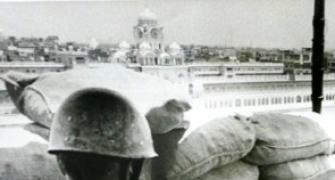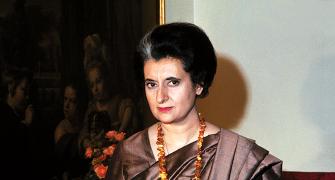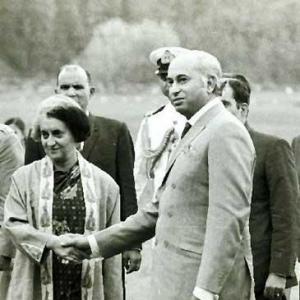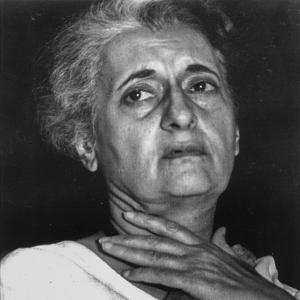'According to me, her finest hour was in 1983-1984 when she neutralised a combined US-Pakistan-British conspiracy to Balkanise India by creating an independent Sikh State of Khalistan,' says Colonel Anil A Athale (retd).
A special assessment of Indira Gandhi on her centenary.
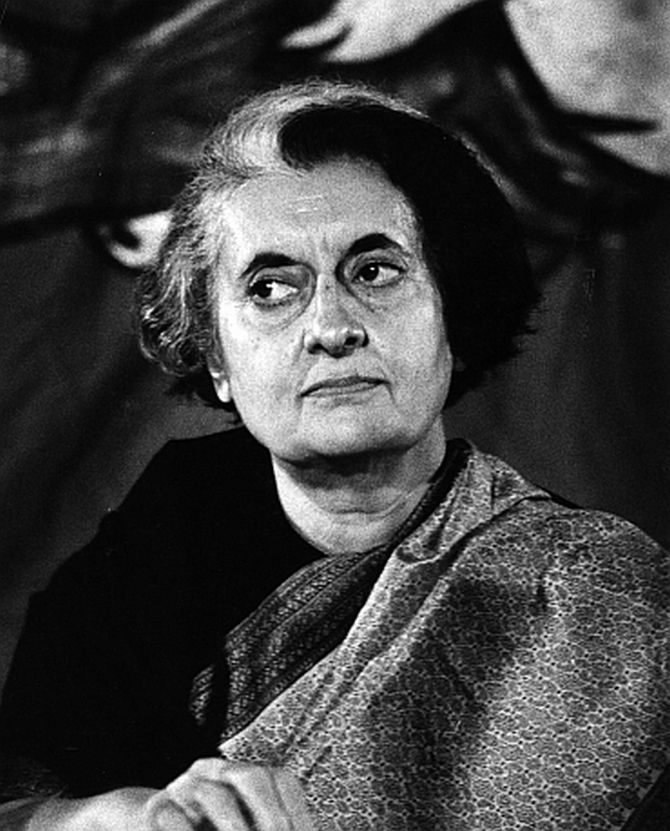
November 19, 2017 is the hundredth birth anniversary of a remarkable Indian who left her mark on the history of India.
Keeping in view my field -- military history -- this two-party essay will attempt to make an assessment of her contribution to the securing of the Republic through the turbulent 1970s and 1980s.
Creation of an independent State of Bangladesh in 1971 is regarded as the high point in her career.
Her record as a war leader, however, is mixed in the sense that what the soldiers won on the battlefield giving their blood, was squandered by her on the negotiating table in Simla in 1972.
She redeemed her reputation as a tough decision maker when in May 1974 she ordered a test of nuclear weapon (called PNE or peaceful nuclear explosion) and ushered India into a nuclear age.
But according to me, her finest hour was in 1983-1984 when she neutralised a combined US-Pakistan-British conspiracy to Balkanise India by creating an independent Sikh State of Khalistan.
She paid the ultimate price for her boldness when she was assassinated by her bodyguards on October 31, 1984.
Creation of Bangladesh.
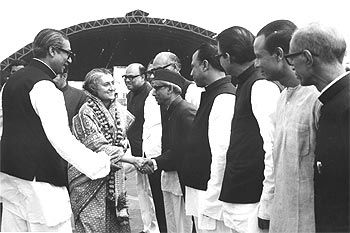
MUST READ: Bangladesh war: 'Nixon, Kissinger let personal judgments cloud their thinking'
Contrary to the current Pakistani view that India interfered in East Pakistan and started the conflict that ultimately resulted in the creation of Bangladesh, the trouble in East Pakistan began in the 1950s.
At that time the Nagas had revolted and started a violent secessionist movement and the Indian Army had to be used to suppress the violence.
In 1959-1960 when the trouble in Nagaland was at its peak, the insurgents received full support with arms and money from the territory of erstwhile East Pakistan.
Indian troubles increased when on March 1, 1968, Mizoram was also engulfed by an insurgency. Like the Nagas, the Mizos were fully supported by Pakistan.
In a response to Pakistani meddling in the North East, India's response was to encourage the separatists in East Pakistan. 1971 was culmination of that process.
India was presented with a golden opportunity in 1965 when the two countries went to war over Kashmir. At that time there were less than 3,000 Pakistani troops in then East Pakistan and India could have walked into East Pakistan, but wisely stayed its hand.
This act of abandoning East Pakistan in 1965 led to further alienation of the Bengalis from Pakistan. The 1970 election in Pakistan saw the charismatic Sheikh Mujibur Rehman, an advocate of regional autonomy, win a complete majority.
The Pakistan army foolishly denied him legitimate power and dismissed his plea for autonomy. The Bengalis in East Pakistan revolted in March 1971 and over 9 million refugees streamed into India to escape persecution.
The majority of these refugees were Hindus who were specifically targeted by the Pakistan army in a campaign of genocide.

MUST READ: The Men Who Made History
Indira Gandhi's response was to order military action in March 1971 itself. But she had the good sense to listen to sage advice by General S H F J Maneckshaw, her army chief, to delay the operations to November-December when the snows would render a Chinese intervention difficult and the dry season would facilitate movement of the invading force.
Indira Gandhi utilised the time between March and November 1971 to rally world public opinion in favour of military action. Her master stroke was when she signed a 'Peace and Friendship Treaty' in August 1971 with the erstwhile Soviet Union and brought in counterveiling Soviet power to checkmate possible Chinese and American interference.
Starting the end of November 1971, the Indian armed forces in a 16 day campaign liberated Bangladesh.
It was a major feat as it was the first instance when a new country was created by force of arms after World War II.
As Atal Bihari Vajpayee then remarked that she not only changed history but geography as well.

MUST READ: 'We fought the battle as if it was the last thing we'd ever do'
Indira Gandhi was overtly influenced by a Delhi lobby that in the hour of victory India should be magnanimous and should not repeat the mistake the Allies made in imposing the harsh Treaty of Versailles in 1919 on Germany at the end of World War I.
She failed to understand the Pakistani DNA that has hatred of India hardwired in. Later at the Simla peace conference, India brought up the Kashmir issue. The Cease Fire Line (agreed to as per the Karachi agreement of 1949) was converted to the LoC or Line of Control, a sort of halfway house between a cease fire line and an international border.
Though not marked on the ground, it is marked on the map in great detail after a joint ground survey. But at the conference it was also agreed to LET EACH SIDE RETAIN THE TERRITORY CAPTURED BY EACH OTHER IN JAMMU AND KASHMIR while withdrawing to its side of the international border (Clause 6, section 4 and 5 Simla Agreement).
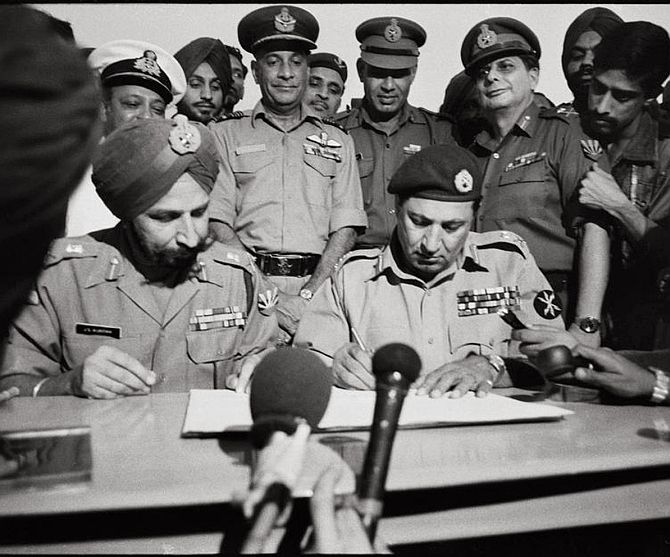
MUST READ: Brilliant commanders and brave men won India the 1971 War
I had a chance to extensively study all the official documents connected with this war (including the minutes of the Cabinet Committee on Political Affairs's meeting; the CCPA was then the top decision making body in the country at the time).
In addition to this, I consulted an individual who was part of the Cabinet Secretariat's military wing. This brought me to the conclusion that there is no hint that retention of captured territory in J&K was a considered policy of the Government of India BEFORE the war. The armed forces were certainly not aware of it.
Effect of this lack of forethought was that on the western front, much of the military effort was concentrated in the plains sector in Punjab, gains that had to be given up.
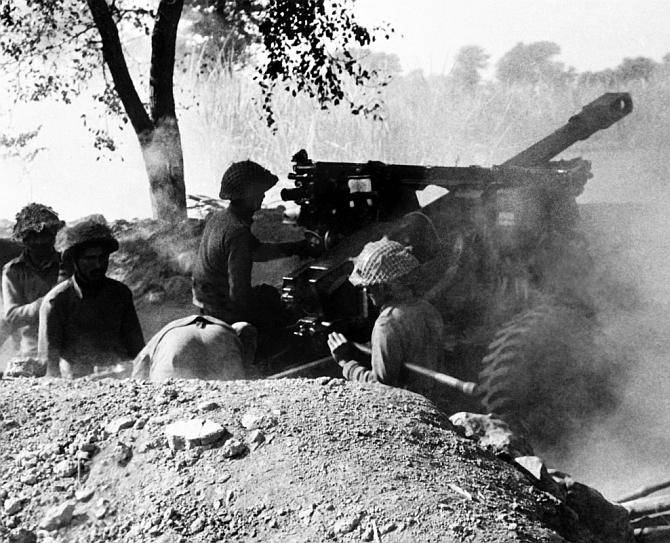
MUST READ: The General who 'created' Bangladesh
On the other hand, an excellent opportunity to consolidate Kashmir or strategic Pakistan occupied areas was wasted.
If India had plans to retain the captured territory in J&K, a major thrust towards Skardu or Gilgit could have threatened the land access between Pakistan and China.
Unlike in 1965 when the Chinese served an ultimatum, in 1971 due to the Soviet build up on the Sino-Soviet border on the Amur river border (almost 44 divisions from the normal 3 or 4), China kept out of this conflict.
As India faces a Sino-Pak joint military threat in the north one can only wonder the effect this blunder has had.
It is difficult to blame the military leadership only for this as in retrospect it appears that the decision to retain gains in Kashmir was a 'spur of the moment afterthought'.
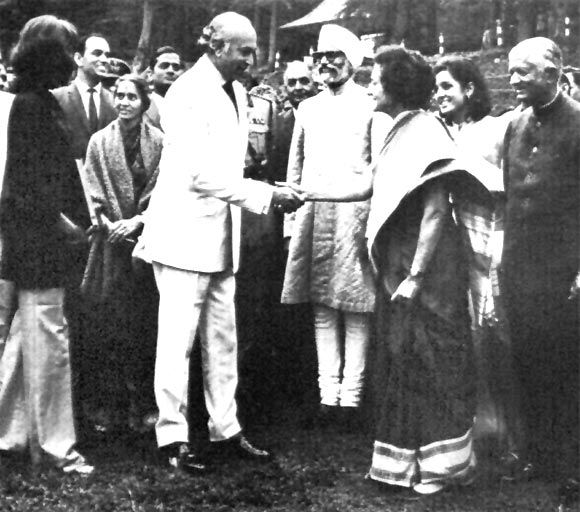
MUST READ: J N Dixit on the Errors of Simla
The second blunder was the explicit recognition that India gave to the 'Kashmir dispute' in the Simla agreement.
Zulfiqar Ali Bhutto came to Simla as the head of a defeated nation with nothing to bargain. 93,000 Pakistani prisoners were in India and the tehsil of Shakargarh as well as large tracts of desert were under Indian occupation.
The Pakistani State itself was tottering and the only card Bhutto had was to play on the Indian need to have a viable Pakistan survive.
Using his weakness dexterously, Bhutto made sure that India could never drive a hard bargain. All that Pakistan conceded at Simla was that it would not use force to solve the Kashmir problem -- a promise never kept as it supported the separatists there.
It also agreed to deal with the issue bilaterally. It is indeed astonishing that a militarily weak and defeated nation promising 'non use of force' against another country ten times its size is being seen as a concession.
This naiveté was to cause immense difficulties in the future. The acceptance of the disputed status of Kashmir was a major diplomatic blunder and India continues to pay a heavy price for it.
India snatched diplomatic defeat from the jaws of victory.
But the greatest blunder was to let the Pakistan army get away with its 'genocide' in Bangladesh.
There is massive evidence of the Pakistan army's brutality in Bangladesh. The evidence is from Pakistani sources itself, the report of the Justice Hamidur Rehaman Commission.
Some of the testimony in that report makes for very chilling reading. The Nazis were tried for massacring the Jews. The Khmer Rouge, Saddam Hussein, Serbian militants -- all faced the courts. Only the Pakistan army got away with murder, rape and loot.
While Bangladesh attempts to get justice for the victims, India is silent.
In Simla on July 2, 1972, Indira Gandhi emulated Prithviraj Chauhan and let Bhutto off the hook on his mere promise: 'Aap hum pe bharosa kijiye! (Have faith in me)'.
Colonel Anil A Athale (retd) is a military historian.


